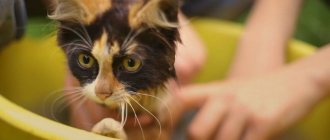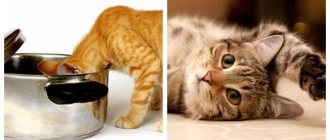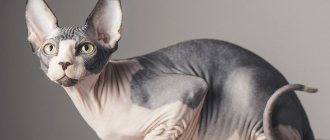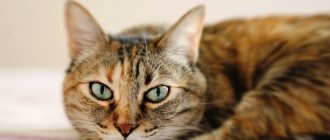Proper diet for cats
- Fact 1:
It is better not to give milk to a Bengal kitten. Only goat (low-fat) is allowed to avoid problems with digestion - Fact 2:
By the way, food for pregnant and lactating cats is also suitable for babies (almost identical composition to food for kittens). - Fact 3:
Bengals do not like fatty meats, so it is better to avoid beef and pork. - Fact 4:
You can cook a porridge mix from cereals, herbs and vegetables (but do not include potatoes, broccoli, onions and garlic)
A Bengal cat is a piece of wild nature in your home. Such beauty was achieved by crossing a simple domestic cat with a wild leopard cat. That is why the Bengal creature has an unusual spotted color and a completely ordinary “domestic” character. Of course, 20% of wild genes sometimes wake up in a pet, which is reflected in its disposition and food preferences.
The wild brothers of the Bengal cat hunt for their own diet: it is exclusively meat. Very rarely, leopard cats practice herbal medicine. Therefore, for the most part, the handsome Bengal will have to be fed with food of animal origin, and industrial food should only be of the highest quality.
Secrets of the Bengal diet
Despite the 100% meat diet of the leopard cat, you need to remember that Bengals are half domestic. And it is not necessary to feed them only meat. At least 20% of the diet should consist of other dishes: sea fish, cereals, vegetables, fermented milk cuisine. It is better not to give milk to a Bengal kitten. Only goat (low-fat) is allowed so that there are no problems with digestion.
You can cook a porridge mix from cereals, herbs and vegetables (but do not include potatoes, broccoli, onions and garlic). It is recommended to add 1 quail egg yolk to the porridge 1-2 times a week. If you have your own farm, or the eggs are purchased from trusted sources, raw yolk is allowed and mixed into the porridge. If the eggs were purchased in a store or from unverified sources, it is better not to take risks: you can infect the kitten with salmonellosis. Sometimes you can replace meat with offal (liver, heart). Bengals do not take well to fatty meats, so it is better to avoid beef and pork.
Make sure that your pet does not come across “surprises” in meat dishes: bones, beaks, skin, claws. The kitten may choke. Food must be at an acceptable temperature. Vitamins and minerals are required and must be discussed with your veterinarian. The kitten should have regular access to fresh drinking water.
List of contraindicated products
When developing a diet for your kitten, do not forget that some foods are simply contraindicated for him. These primarily include milk - it causes stomach upset. But yogurts, kefir and yogurt will become an important source of protein.
You should immediately give up potatoes and eggplants - Bengals tolerate them very poorly.
Also, don't get carried away with fish. In the wild, Bengal cats eat it extremely rarely, and therefore are not very adapted to digest it. In addition, frequent consumption of fish causes serious problems with the urinary system.
Ready-made food: tips and nuances
If you decide to please your Bengal pet with the highest quality industrial food, make sure that the label says “For kittens.” By the way, food for pregnant and lactating cats is also suitable for babies (almost identical composition to food for kittens). It’s impossible to say for sure which industrial food your baby will love. Cats, like people, have their own food preferences.
But wise intervention by the owner in the diet is mandatory. It is better not to mix different brands of food, just as you should not give ready-made food with “natural” food in the same bowl. Make it a rule: each type of food is in its own bowl.
Expert cat breeders recommend Royal Canin for any breed as a proven food. But besides this, there are several other excellent cat treats.
Dry food
- "Royal Canin Mother & Babycat" . Suitable for both pregnant cats and babies up to 4 months (although many owners successfully give this food to kittens up to 7 months of age). Special proteins and prebiotics are perfectly absorbed, and vitamins and antioxidants support the Bengal baby’s immunity. Pieces of food are easy to soak, which helps to painlessly transfer the kitten from milk to solid food.
- "Royal Canin Kitten " Recommended for kittens from 4 months to one year. Special proteins and fiber from plantain seeds take care of the baby’s gastrointestinal tract, regulate the balance of intestinal microflora and relieve problems with stool. The food is rich in vitamins and is able to fully provide energy and protection to the kitten’s growing body.
- "Sanabelle Kitten " Suitable for pregnant cats and babies up to one year old. Amino acids of the highest quality and the correct proportion of nutrients have a beneficial effect on the entire cat’s body: strengthens bones and teeth, regulates the gastrointestinal tract, takes care of the kitten’s fur and skin, and most importantly, supports its strong immunity. Experts joke that this food is so tasty and safe that the owners themselves would gladly feast on it if not for moral prejudices.
Wet food (canned)
- "Pro Plan Nutris Vour Junior" . Everything a small cat's body needs is contained in a serving of this healthy food. Omega-3 fatty acids improve vision and brain function. Calcium and phosphorus build the baby's skeleton and muscles. The balanced formula of the canned food is suitable for the first feeding of a kitten, as well as for a nursing mother cat.
- "Iams Kitten & Junior Chicken in Sause" . Canned chicken meat is great for kittens from 3 weeks to one year. The appetizing pieces in the sauce contain the required amount of all valuable substances: proteins, calcium, phosphorus, fiber, fats and vitamins. Their correct balance helps the kitten to fully develop and have a healthy, strong immune system. Canned kibble can be mixed with any other food to make your pet’s diet as tasty and healthy as possible.
Breed Features
Are you planning to get a Bengal cat? Then, before the kitten arrives, we recommend that you learn about the nuances of keeping, care, and characteristics of this breed.
Important! Knowing the characteristics of the breed, you can easily organize a nutrition system, select a diet, and provide proper care for your furry pet.
The Bengal cat is a hybrid breed that was developed through interbreeding (wild and domestic Bengal cats). At the beginning of the formation of this breed, cats of various breeds were used in selection. As a result of painstaking work, modern Bengals have the appearance of wild descendants and the affectionate disposition of domestic cats.
Bengal cats have a muscular, elongated build. Weight is approximately 5-7 kg. The hallmark of this breed can be called the leopard color.
Bengal cats cannot be called very sociable pets. Wild kittens show distrust of humans. At the same time, the descendants of domestic Bengals, although they have a rather independent character, in which the features of wild relatives are visible, with proper socialization and proper care they become attached to members of their family.
Important! Bengals choose only one or at most two owners whom they trust and become attached to.
It is best to adopt kittens at the age of 2.5-3 months. It is necessary to socialize Bengals and instill in them the necessary habits from the first days.
https://www.youtube.com/watch?v=KkMFZdubrsM
Bengals have a short intestine and a sensitive digestive tract. The breed is prone to food allergies and intestinal disorders. Cats are often diagnosed with inflammatory gastrointestinal diseases. Therefore, think over your diet long before the Bengal kitten arrives in your home.
Forbidden food for Bengal kittens
Despite the fact that representatives of the Bengal breed are not prone to gluttony, they, like all cats, are curious and can beg their owner for delicacies that interest them. But the following foods are prohibited for kittens:
- cow's milk;
- fatty (and raw) meat: beef, turkey, duck, pork;
- bones of any kind;
- River fish;
- vitamin complexes for people;
- “human” dishes: roasts, soups, stews, salads;
- peas, beans;
- any sweets;
- flour;
- fruit seeds;
- fresh tomatoes and potatoes;
- garlic/onion.
Babies should be fed at the same time every day. If it is difficult for a kitten to chew dry food, it should be soaked in water or skim milk. Feed granules that are too large must be crushed. It is better not to mix dry food with natural food: in order to digest these different types of food, the cat's stomach produces different enzymes. Any failure can lead to indigestion and unpleasant consequences.
Upbringing
The efforts of the owner determine how cute the kitten will grow up to be. The breed is not particularly difficult to train. Its representatives easily remember all the requirements placed on them. They get used to the tray quickly. But they can walk by if the cat litter box is not very clean. Therefore, it is better to use wood filler. It masks odors and is pleasant to rummage through. And Bengals tend to bury their excrement. Therefore, choose a pot with high sides for them.
Bengals are very playful. They should have their own toys. Otherwise, pets will find replacements for them in the form of the owner’s things. If you don't want your animal to seek adventure, play with it as often as possible. This will help establish contact with the purr.
It is important to teach the animal to respond to the “No” command. At first, it can be combined with pinching the baby’s neck. This is how his mother cat taught him, and this touch is familiar to him. But you should not use violence against your pet. This will undermine his trust in you. Damaged relationships will be difficult to renew.
If you plan to walk your pet outside, teach him to calmly respond to the collar. Always wear a comfortable harness when walking in the city or outdoors. These animals are very curious. Without a leash, they can harm themselves by going to explore unknown worlds.
Bengals not intended for breeding are neutered before the age of 6 months. This is a simple operation. Cats tolerate it well. Sexually mature cats not only create inconvenience in the house, leaving marks everywhere, but can also run away during the “hunt.”
Age feeding scheme
At 3 weeks, the kitten must be introduced to the first complementary food consisting of pasty food (or special industrial food). Dry crushed food can be given at the age of 1.5 months. Up to 2 months, a kitten should eat 7-8 times a day. Below is the diagram:
- 1.5 – 2 months . The baby can only eat mother's milk, but it is recommended to supplement it. This can be industrial food or boiled meat, cut into small pieces. But babies eat pates/canned food better. The kitten should be fed 6 times a day.
- 3 months . The kitten is already able to chew dry food granules on its own. Dairy dishes should be reduced to 20% of the rest of the food. You can feed 5 times a day.
- 4 months . 40% of the diet should consist of cereals and vegetables, 60% - meat. At this age, the kitten can already begin to demonstrate its food preferences. An attentive owner will definitely notice them. The kitten is fed 4 times a day.
- 5 months . The diet includes fermented milk cuisine. The cat gradually gets accustomed to raw meat. Dry food no longer needs to be crushed or soaked. The kitten eats 3 times a day.
- 6-12 months . The baby is already ready for an “adult” diet. But he still really needs important vitamins and minerals as the body actively grows. It is better to choose products containing easily digestible proteins. The veterinarian will tell you what vitamins your pet needs.
If you have placed a piece of wild nature in the person of a Bengal kitten under your roof, be prepared to carefully take care of the menu of this unique creature. And his “thank you” will definitely be reflected in a shiny, healthy coat and a grateful purr.
How to switch to a different type of feeding or other foods
Adding new products to the diet, switching to any new food - dry or wet, and even more so changing the type of feeding - is a very important moment for the proper nutrition of a Bengal cat. The process should be carried out step by step, with observation and great care. Experts have developed an algorithm for this, adhering to which the owner will not harm the animal. The procedure for introducing food new to a Bengali is as follows:
- first and second days: the cat is offered only 20-25 percent of unfamiliar food;
- the third and fourth days, if no problems are found, the usual and new food are given in equal shares;
- on the fifth day you can try a 100% transition to a new diet.
All this time you need to monitor the well-being of the Bengal cat and take an interest in the contents of its potty. In case of alarming symptoms (loose stools or constipation, spotting, refusal to eat), you should return to the previously tested method of feeding, to the previous foods.
The owner decides how best to feed his Bengal pet. However, if you strictly follow the described recommendations, then even with such a feature of the genetics of Bengal cats as an overly sensitive stomach, no special troubles with feeding are expected. You just need to pay a little more attention to the diet and, most importantly, the quality of food than representatives of other breeds. Proper nutrition is the key to a long and happy life for a Bengal cat.
Health, tendency to disease
This is a hardy breed with good health. The first Bengals only had problems with the gastrointestinal tract. Pets still often have intestinal disorders. But over time, other diseases began to appear in pets. These are hypertrophic cardiomyopathy (HCM) and flat chest syndrome (FCK) in kittens. Allergies are not that uncommon.
As for the weak immune system, it is characteristic of lines in which matings between close relatives were allowed more than once. Such individuals must be regularly vaccinated and dewormed.
Disease Prevention
- A well-chosen diet - the food must be fresh and of good quality.
- Annual examinations with a veterinarian - an experienced specialist will identify most dangerous diseases at an early stage.
- Vaccination - kittens are vaccinated in the nursery, then the new owner must adhere to the vaccination schedule against the most common feline diseases.
- Control of parasites – the Bengal needs to be protected from helminths, ticks and fleas.
- Sterilization – if animals are not involved in breeding, they must be sterilized. There is no other option. There is no such thing as “giving birth for health.”
It is forbidden!
Fatty meats: pork, duck, goose, turkey, lamb. Pork is especially dangerous for Bengal cats, as it may contain eggs of dangerous parasites that are not destroyed by freezing. River fish - small bones, like bird bones, are not digested, clog the digestive tract, and lead to minor internal injuries. Small bones, especially poultry long bones, can injure the intestines. Sweets in any form are contraindicated, as for all cats. Especially chocolate, which contains theobromine. Spicy, salty and smoked foods cause water-salt imbalance in cats and provoke the development of urolithiasis. Potatoes, due to the starch they contain, are almost completely indigestible and provoke gastrointestinal disorders. Due to the large amount of nitrogen, legumes do not have time to be completely digested and cause increased gas formation and fermentation of the intestinal masses. Spices are contraindicated not only because of the risk of metabolic disorders, but also because of the pungent odor, which can cause pathologies of the sense of smell.
https://youtu.be/bEqk1XE15Mw











